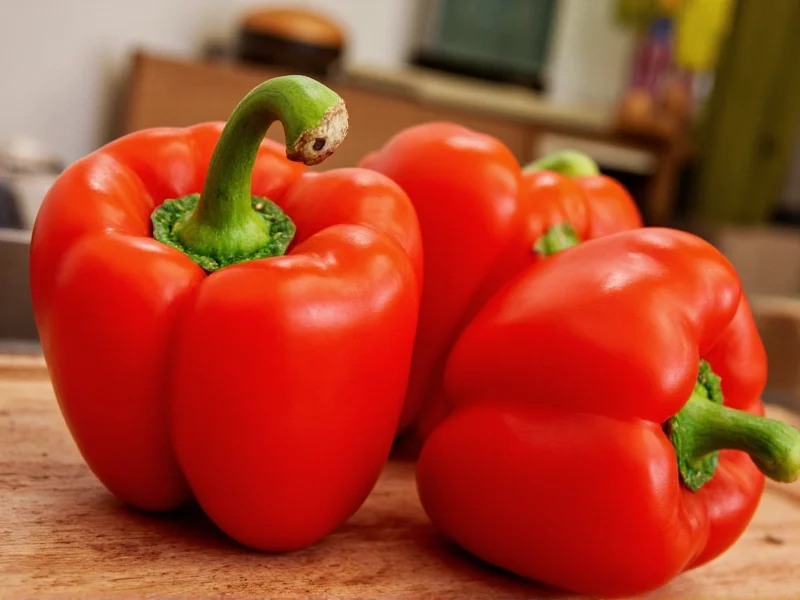One cup (159g) of roasted bell peppers contains approximately 35 calories, with a medium roasted bell pepper (119g) providing about 25 calories. Roasting peppers doesn't significantly alter their calorie content compared to raw peppers, though slight variations occur due to water loss during cooking.
Understanding the nutritional profile of roasted peppers is essential for anyone tracking their dietary intake. Whether you're meal prepping, following a specific diet plan, or simply curious about healthy food options, knowing the exact calorie count in roasted peppers helps make informed dietary choices. This comprehensive guide provides accurate nutritional information based on USDA data and explains how roasting affects the nutritional composition of different pepper varieties.
Nutritional Breakdown of Roasted Peppers
Peppers undergo minimal nutritional changes when roasted compared to their raw counterparts. The primary difference comes from water evaporation during the cooking process, which slightly concentrates certain nutrients while leaving calorie content relatively stable.
| Pepper Type and Serving | Calories | Carbohydrates (g) | Fiber (g) | Vitamin C (%DV) |
|---|---|---|---|---|
| Bell pepper, roasted, 1 cup (159g) | 35 | 8.5 | 3.1 | 200% |
| Bell pepper, roasted, medium (119g) | 25 | 6.3 | 2.3 | 150% |
| Red bell pepper, roasted, 1 cup (159g) | 40 | 9.8 | 3.4 | 300% |
| Jalapeño, roasted, 1 pepper (14g) | 5 | 1.2 | 0.4 | 20% |
Raw vs. Roasted Peppers: Nutritional Comparison
Many people wonder whether roasting peppers changes their nutritional value significantly. The truth is that while some water-soluble vitamins like vitamin C may decrease slightly during roasting, the overall nutritional profile remains remarkably similar to raw peppers.
Roasting actually enhances the availability of certain antioxidants like carotenoids. The heat breaks down cell walls, making these beneficial compounds more accessible to your body. This means that while vitamin C content might decrease by 10-15% through roasting, the bioavailability of other important nutrients increases.
When calculating calories in roasted peppers for meal planning, remember that roasted peppers weigh less than raw peppers due to water loss. A raw bell pepper weighing 120g might reduce to 100g after roasting, which means the same volume of roasted peppers will contain slightly more calories than raw peppers simply because there's less water content.
Different Pepper Varieties and Their Caloric Content
Not all peppers are created equal when it comes to nutritional content. Understanding the differences between varieties helps you make better dietary choices:
- Bell peppers: The most commonly roasted variety, available in multiple colors. Red bell peppers contain slightly more calories and significantly more vitamin C than green varieties due to longer ripening time.
- Roasted poblano peppers: Larger than bell peppers with a distinctive flavor. One roasted poblano (80g) contains approximately 20 calories.
- Chili peppers: Much lower in calories due to smaller serving sizes. Even when roasted, a single jalapeño contains only about 5 calories.
- Roasted sweet banana peppers: Similar in calorie content to bell peppers, with one medium roasted pepper (65g) providing about 15 calories.
Health Benefits Beyond Calories
When considering calories in roasted peppers, it's important to look beyond just the energy content. Peppers offer numerous health benefits that make them valuable additions to any diet:
- Vitamin C powerhouse: Just one cup of roasted red bell peppers provides over 300% of your daily vitamin C needs, supporting immune function and skin health.
- Rich in antioxidants: Roasting enhances the availability of carotenoids like beta-carotene and lycopene, which help protect against cellular damage.
- Low energy density: With only 35 calories per cup, roasted peppers provide substantial volume and nutrients with minimal calories, making them excellent for weight management.
- Dietary fiber source: Roasted peppers contain about 3 grams of fiber per cup, supporting digestive health and promoting feelings of fullness.
Practical Applications for Calorie-Conscious Eating
Knowing the precise calories in roasted peppers allows you to incorporate them strategically into various dietary approaches. For those tracking daily intake, roasted peppers offer a flavorful way to add volume to meals without significantly increasing calorie count.
Chefs and home cooks can use roasted peppers to enhance dishes while maintaining nutritional goals. Adding half a cup of roasted peppers (approximately 18 calories) to omelets, salads, or grain bowls provides flavor complexity with minimal caloric impact. The natural sweetness that develops during roasting makes them an excellent substitute for higher-calorie flavor enhancers.
For meal preppers tracking calories in roasted peppers, proper storage is key. Roasted peppers maintain their nutritional value for 3-5 days when stored in airtight containers in the refrigerator. Freezing roasted peppers preserves their nutritional content for up to 6 months, making them convenient for future low-calorie meal additions.
Measuring Roasted Peppers for Accurate Calorie Tracking
Accurate measurement is crucial when tracking calories in roasted peppers. Many people make the mistake of using volume measurements (cups) without considering how much the peppers have shrunk during roasting.
For precise calorie counting, use a kitchen scale to weigh roasted peppers before adding them to your meals. Since water loss during roasting concentrates the nutrients slightly, 100g of roasted peppers will contain marginally more calories than 100g of raw peppers. This difference is small (typically 5-10% more concentrated), but matters for those strictly monitoring their intake.
When following recipes that call for roasted peppers, check whether measurements refer to pre-roasting or post-roasting weight. This distinction significantly impacts the actual calorie content of your finished dish.











 浙公网安备
33010002000092号
浙公网安备
33010002000092号 浙B2-20120091-4
浙B2-20120091-4